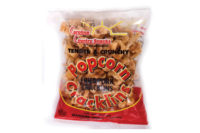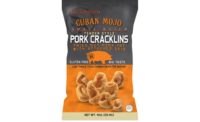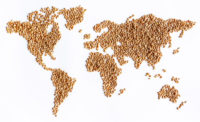Pork rinds continue to see strong growth, with retail category sales up 5.6% to $630.0 million for the 52 weeks ending April 17, 2022, according to multi-outlet plus convenience store data from IRI, Chicago (for a deeper look at the overall puffed and extruded snack market, including pork rinds, see “State of the Industry 2022: Puffed and extruded snacks offer variety, healthy options”).
In order to gain some perspective on the drivers of this growth, we reached out to Mark Singleton, vice president of sales and marketing, Rudolph Foods, a company that also produces the Southern Recipe Small Batch brand.
Douglas J. Peckenpaugh: Over the past few years, we’ve seen the pork rind market get hot, with good category growth year over year, and some strong flavor innovation in the category. How is the typical American pork rind consumer changing?
Mark Singleton: It has really been amazing. We’ve been making pork rinds since 1955, so we’ve seen the market go from very rural consumer, very southern consumers to a much broader base. Lately, the combination of Atkins, and then later keto, really redefined the product for so many consumers.
The pork rind shelf has really opened up. There are more consumers who are willing to buy them as long as they aren’t in a clear bag that looks like they were made in a garage, with a limited number seasonings, basically hot or Barbecue. Over the last several years, we’ve seen a tremendous number of products with flavors like kimchi barbecue or pink Himalayan sea salt—flavors you only typically see on kettle chips, really aspirational items. That brought a whole new consumer in.
You asked about who the pork rind consumer is today? Our No. 1 consumer now is households that make $100,000 or more. I would have never believed that as short as six years ago.
DJP: It’s growing the category, and it has been fantastic to see. Category growth can sometimes push snack producers to their operational limits, which has challenged equipment capabilities. COVID-19 added surges in demand. We also continue to deal with intermittent supply-chain challenges. How have things been from an operational perspective over the past few years at Rudolph Foods?
MS: We’re family-owned, and we’ve been doing this since 1955. We try to stay ahead of where we need to grow and how we need to grow. We added two plants to cover demand.
Getting two new plants up and operational was a challenge. But most of our people have been with us for a long, long time. They figured out a way to do it through a combination of Zoom and site visits. And while we try and stay ahead of things, I have to say we have run out of things I didn’t think we could run out of. Suppliers that in the past have never been light have been light. The No. 1 priority is taking care of your existing customers. Then you need to figure out a way to simplify the business a little bit to help our employees out. I don’t think it’s ever been any tougher than right now. But we’ve had some of our suppliers and customers for 50 years, and so the level of communication, the level of partnership from some of our customers, has been just great. They’ve been very understanding, working with us to be flexible.
America needs to be more grateful for the food workers out there. These people have come through for us during really hard times. They did a fabulous job, and need to get their credit. This includes truck drivers, really critical employees.
DJP: When a system comes under pressure, you really see how a company culture can shine through, to help you persevere through even the hardest times. We’ve certainly seen our fair share of pressure over the past few years. It’s good to hear that workforce culture is strong over at Rudolph Foods. Are you able to find enough folks to staff your lines?
MS: I think we have a real challenge as a nation. Our geography is tougher than some others when it comes to staffing. There are some places that have more labor availability. But we’re very lucky we have multigenerational families working for us one, two, three generations. So we have a natural inflow of folks. Some of our people have been around our company since they were young. We’ve seen children of employees grow up and then become part of our family. It’s just amazing.
DJP: What’s next for Rudolph Foods?
MS: We have a new major plant expansion in Dallas that we’re really excited about. It’s going to have state-of-the-art everything, including online seasoning so we can go from one seasoning to another. I think one of the trends that you’re going to see is a continuous exploration of the world’s flavors. Maybe Moroccan, North African flavors. I think we’re going to see more hot honey. I think it’s a great time to explore flavors.
Today we have the most-knowledgeable consumers in the history of the world. I’m convinced that the availability of information leads them toward “purposeful eating.” They’ve done their research. They know what works for them. And they’re hungry for more.





